15 years one-stop China custom CNC machining parts factory
 264 |
Published by VMT at Feb 13 2025 | Reading Time:About 8 minutes
264 |
Published by VMT at Feb 13 2025 | Reading Time:About 8 minutes
In the world of modern manufacturing, welding is a key process for joining metals together. However, when it comes to high-volume production with precision and speed, spot welding emerges as one of the most efficient methods. But what is spot welding, and why is it so important in various industries? In this article, we will dive into the fundamentals of spot welding, its purpose, and why it is integral to many CNC machining applications.
Spot welding is a process that uses heat generated by electrical resistance to join two metal sheets together at a specific point. Unlike traditional welding methods that rely on an open flame, spot welding focuses on creating localized heat, making it ideal for joining thin metal sheets quickly and effectively. During the process, electrical current passes through the metal workpieces, generating heat at the contact points where the metal is fused together.
In CNC machining, spot welding is often employed to join smaller components or sheet metals with precision, ensuring durability without the need for additional fasteners. It's one of the most cost-effective and reliable methods used in industries like automotive manufacturing, electronics, and sheet metal fabrication.
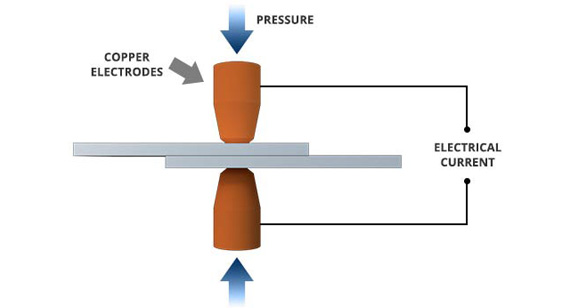
Spot welding operates through the principle of resistance to electric current. When two pieces of metal are clamped between copper electrodes, an electric current is passed through the workpieces. The resistance of the metal creates heat at the points where the metal sheets meet, melting the surface layers and forming a weld.
The spot welding process typically involves several stages:
This precise application of heat and pressure results in a high-strength joint without the need for fillers or additional materials.
Spot welding serves several key purposes in manufacturing and fabrication:
Spot welding is a fundamental process in modern manufacturing, offering several advantages that make it essential for a wide range of applications, from automotive production to electronics assembly. Understanding the importance of spot welding can help businesses and manufacturers improve their production efficiency, quality, and cost-effectiveness.
1. Holds Components in Place in Preparation for Joining
One of the primary reasons why spot welding is so crucial is its ability to hold metal components securely in place during the manufacturing process. This precise positioning eliminates the need for clamping fixtures, helping to streamline production and reduce setup time. Whether in automotive or aerospace industries, spot welding ensures that metal sheets and parts are aligned perfectly before the final welding process, ensuring strong, uniform bonds.
2. Ensures Proper Alignment of Components
For many industrial applications, the alignment of components is critical to ensuring the functionality and integrity of the final product. Spot welding provides an efficient solution by holding parts in place and maintaining the required gap between them. This ensures the components are perfectly aligned before the welding process, preventing misalignment that could lead to weak joints or product failure.
3. Improves the Functionality of Fixtures or Eliminates the Need for Fixtures Altogether
In many manufacturing processes, custom fixtures are required to hold components in place. Spot welding, however, can often eliminate the need for these fixtures entirely. By using spot welds to secure components temporarily, the process becomes faster, simpler, and more cost-effective. This reduces the need for expensive fixture designs and makes the entire manufacturing process more flexible.
4. Helps Control Distortion During the Final Weld
When components are welded, excessive heat can cause distortion. Spot welding allows manufacturers to control the amount of heat applied to the joint, reducing the risk of warping or misalignment during the final weld. By using localized heat and pressure, spot welding minimizes the potential for thermal distortion, ensuring that the parts retain their original shape.
5. Ensures Mechanical Strength of Components
Spot welding also plays a key role in ensuring the mechanical strength of components, particularly in applications where the parts will be subjected to movement or stress. The localized heat and pressure used in the spot welding process create a strong, permanent bond that can withstand significant loads. This makes spot welding ideal for applications in automotive, aerospace, and construction industries, where strength and durability are critical.
6. Cost-Effectiveness and Speed
Spot welding is known for its speed and efficiency, making it a cost-effective solution for high-volume production. Unlike traditional welding methods, spot welding can be performed in seconds, reducing labor and equipment costs. Its speed is especially beneficial in industries where time is of the essence, and parts must be welded quickly without sacrificing strength or quality.
7. Versatility Across Different Materials
Spot welding is compatible with a wide variety of materials, including mild steel, stainless steel, aluminum, and other metals commonly used in industrial applications. This versatility allows manufacturers to use spot welding for a broad range of products, from car bodies to electronics enclosures. The ability to work with different materials expands the potential uses of spot welding across various industries.
In summary, spot welding is indispensable because it offers a reliable, fast, and efficient way to join metal components. Its ability to hold components in place, maintain proper alignment, control distortion, and provide mechanical strength makes it a critical process for many industries. When applied correctly, spot welding enhances both the quality and efficiency of manufacturing operations, ultimately improving product performance and reducing production costs.
Spot welding is a versatile joining process capable of handling a wide range of materials. The ability to spot weld various metals depends on their thermal conductivity, thickness, and overall weldability. Below are some of the most commonly used materials in spot welding, each offering unique advantages for different industries and applications.
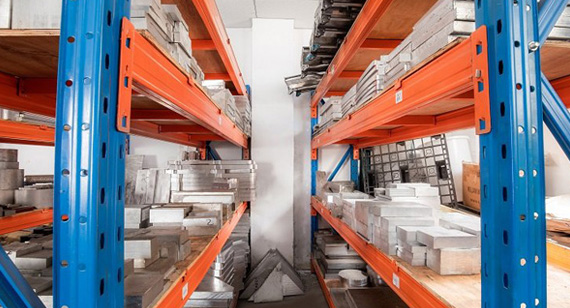
1. Steel
Steel is one of the most common materials used in spot welding due to its relatively low thermal conductivity, making it easier to form a strong, reliable weld. Mild steel, in particular, is highly suitable for spot welding because it can tolerate the localized heat generated during the process without excessive distortion. Steel is widely used in automotive manufacturing, construction, and heavy machinery, where strength and durability are paramount.
2. Stainless Steel
Stainless steel is another popular material for spot welding, although it requires more careful control of welding parameters due to its higher thermal conductivity and varying alloy compositions. Stainless steel is highly corrosion-resistant and has a high tensile strength, making it an excellent choice for industries where both strength and corrosion resistance are critical.
3. Aluminum
Aluminum presents a unique challenge for spot welding due to its high thermal conductivity and tendency to form oxides on the surface. However, when spot welding is done correctly, aluminum can produce strong, clean joints. Spot welding aluminum requires higher heat input and precise control to avoid problems such as burn-through or inconsistent welds.
4. Cast Iron
Cast iron can be spot welded, but it is more challenging than steel or stainless steel due to its brittleness and high carbon content. Special care must be taken to control the heat during the welding process to prevent cracking or excessive distortion. Cast iron is often used in applications that require good wear resistance, such as engine blocks or heavy machinery components.
5. Copper
Copper is a highly conductive material, which means it dissipates heat very quickly. While it can be spot welded, it requires a higher welding current and more precise control to ensure the weld is strong and clean. Copper's ability to resist corrosion and its excellent electrical conductivity make it ideal for use in electrical and electronic applications.
6. Brass
Brass, an alloy of copper and zinc, is another material that can be spot welded, although it also presents challenges due to its low melting point and high conductivity. Brass is often used in applications where a balance of strength, corrosion resistance, and aesthetic appearance is required. It is also easier to weld than pure copper due to its slightly lower conductivity.
7. Titanium
Titanium is a high-strength, lightweight material that is often used in aerospace, medical, and high-performance industrial applications. It is highly resistant to corrosion but can be difficult to spot weld due to its low thermal conductivity and the formation of brittle phases during welding. Specialized techniques and careful control of heat input are necessary when welding titanium.
8. Magnesium Alloys
Magnesium alloys are lightweight and offer excellent strength-to-weight ratios, making them ideal for applications in the automotive and aerospace industries. However, magnesium alloys are more challenging to spot weld due to their lower melting point and tendency to react with oxygen during welding, which can cause defects like porosity. Spot welding of magnesium alloys requires high heat and careful control to ensure high-quality welds.
In summary, spot welding can be applied to a variety of materials, each with its own set of challenges and benefits. The choice of material depends on the specific requirements of the application, such as strength, corrosion resistance, and thermal conductivity. By understanding the properties of each material, manufacturers can optimize the spot welding process to achieve the best results.
Spot welding is a precise process, and the parameters need to be adjusted based on the thickness of the materials being welded. The correct balance of welding current, electrode size, technique, and heat input is essential for ensuring high-quality welds, especially when working with different material thicknesses. Below, we’ll explore how these factors influence the spot welding process for various material thicknesses.
1. Welding Current
The welding current, or the amount of electrical current used in the spot welding process, plays a critical role in determining the size and quality of the weld. For thinner materials, a lower welding current is typically sufficient because less heat is needed to form the weld. However, for thicker materials, higher welding currents are required to generate enough heat to penetrate the material and produce a strong weld.
2. Electrode Size
The size of the electrodes used in spot welding is directly related to the material thickness. Larger electrodes have a greater surface area, allowing for better heat distribution, which is particularly beneficial when welding thicker materials. Conversely, smaller electrodes are used for thinner materials to concentrate heat at the weld interface.
3. Welding Technique
The welding technique, including the timing and pressure applied during the spot welding process, must be adapted depending on the material thickness. Thicker materials generally require longer welding times to allow the heat to penetrate deeply and create a solid bond. For thinner materials, the welding time must be shorter to avoid excessive heat accumulation and prevent burn-through.
4. Heat Input
Heat input refers to the amount of heat energy supplied to the material during the welding process, which is a combination of welding current, welding time, and pressure. Heat input is especially critical when dealing with materials of varying thicknesses, as improper heat input can lead to undesirable results such as incomplete fusion, burn-through, or weak welds.
In conclusion, material thickness is a crucial factor in determining the right parameters for spot welding. Understanding how welding current, electrode size, welding technique, and heat input influence the process allows manufacturers to adapt their approach and ensure high-quality, durable welds. By adjusting these variables appropriately, the spot welding process can be optimized for materials of different thicknesses, leading to stronger and more reliable welds.
Spot welding is a versatile joining process that uses heat and pressure to create a strong bond between two or more workpieces. While the most common form of spot welding is standard spot welding, there are several specialized types of spot welding techniques designed to meet different application requirements. Each type has its unique characteristics, advantages, and uses in various industries. Below are the different types of spot welding techniques:
1. Standard Spot Welding
Standard spot welding is the most widely used form of spot welding, particularly for joining thin sheets of metal. In this process, two electrodes apply pressure and pass a current through the workpieces at the spot where they are in contact. The heat generated by the electrical resistance at the contact point causes the metals to melt and fuse together.
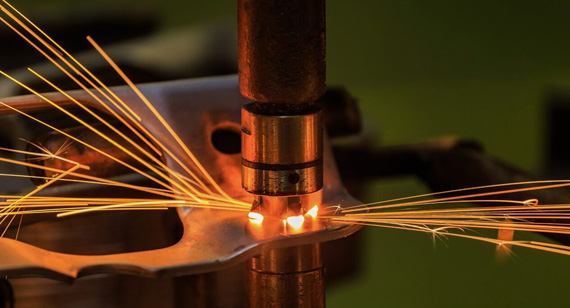
2. Bridge Spot Welding
Bridge spot welding is a variation of the standard spot welding method, used specifically for joining thicker materials or those with irregular shapes. In bridge spot welding, the workpieces are joined by creating a "bridge" of molten metal between the two parts. This method helps create a stronger bond between materials that cannot be effectively welded by standard spot welding.
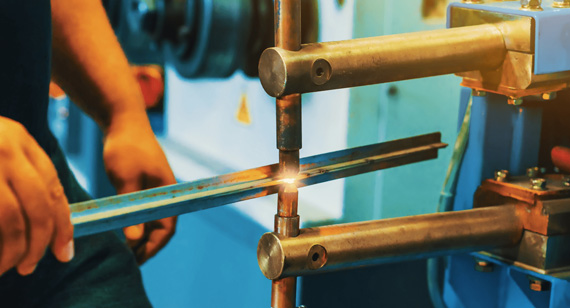
3. Hot Spot Welding
Hot spot welding is a type of spot welding where the workpieces are heated to a higher temperature than in standard spot welding. The process involves heating the metal to a molten state at specific spots, which increases the strength and durability of the bond.
4. Thermic Adhesive
Thermic adhesive welding, also known as thermic welding, combines heat and a thermoplastic adhesive to join materials. This method uses a thermoplastic adhesive to bond parts together, which is then melted by the heat applied during the welding process. This type of welding provides an additional layer of bonding strength and is often used for joining dissimilar materials.
5. Thermal Bonding
Thermal bonding is a non-fusion welding technique that involves heating two materials to a temperature where they can be bonded together by the application of pressure. Unlike traditional welding, the materials do not melt completely; instead, they soften and fuse at the interface.
6. Ultrasonic Bonding
Ultrasonic bonding uses high-frequency ultrasonic vibrations to generate heat and create a bond between materials. The ultrasonic energy is focused on the point where the materials are joined, causing them to melt and fuse together under pressure. This process is quick and precise, typically used for joining thin or delicate materials.
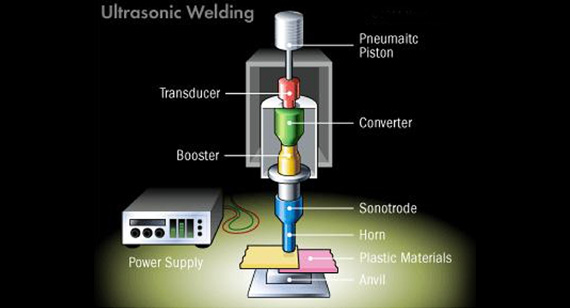
Conclusion
The choice of spot welding type depends on the materials being joined, the required strength of the weld, and the specific application needs. Standard spot welding is widely used for general applications, while other methods like bridge spot welding, hot spot welding, thermic adhesive, thermal bonding, and ultrasonic bonding cater to more specialized requirements. Each of these techniques brings its unique benefits, allowing manufacturers to select the most suitable process for achieving the desired weld quality and strength.
If you are interested in exploring how these techniques can be applied to your specific needs, a consultation with a CNC machining service provider can offer insight into the best options for your project.
Spot welding is a versatile process, but its effectiveness depends on the type of weld required and the material being used. There are four primary forms of spot welding, each designed to address specific needs in the manufacturing and assembly process. Understanding these four forms of spot welding and when to use them can help optimize the quality of welds and ensure efficient production.
1. Square Spot Welding
Square spot welding is the most common form of spot welding and refers to the process where the electrodes are placed perpendicular to the surface of the workpieces. The welds created in this manner have a square or slightly rectangular shape. Square spot welding is typically used for flat, sheet-like materials that are easy to align.
2. Vertical Spot Welding
Vertical spot welding involves welding the workpieces in a vertical orientation. The process remains similar to square spot welding, but the position of the material changes to a vertical plane. This method is typically used in situations where parts are not easily accessible for horizontal welding or when the orientation of the workpieces naturally requires vertical alignment.
3. Right-Angle Spot Welding
Right-angle spot welding is used when the materials to be welded are positioned at a 90-degree angle to each other. In this form, the electrodes are applied to both workpieces at the point where they meet at a right angle. This method allows for the creation of strong welds at the junctions of components that are often used in structural frames or other applications where parts meet at a corner.
4. Right-Angle Corner Spot Welding
Right-angle corner spot welding is a specialized form of spot welding used when joining two parts at a corner, where both parts are at a 90-degree angle to each other. The electrodes are placed at the corner joint, and pressure is applied at that point to form the weld. This technique ensures that the two components are securely bonded together at the corner where they meet.
Conclusion
The four forms of spot welding—square spot welding, vertical spot welding, right-angle spot welding, and right-angle corner spot welding—each offer specific benefits depending on the materials, shape, and orientation of the parts being welded. Whether you're working with flat sheets of metal, complex angular joints, or vertical assemblies, understanding the different types of spot welding can help ensure the quality, strength, and efficiency of your welds.
Choosing the right type of spot welding is crucial for improving product quality and ensuring the longevity of welded joints. If you're looking for more detailed guidance or need spot welding services for a custom project, consider reaching out to a CNC machining service provider who can offer the right expertise and support for your needs.
Spot welding is a widely used technique in industries such as automotive, manufacturing, and aerospace due to its speed, efficiency, and cost-effectiveness. However, like any welding method, it has both its advantages and limitations. Understanding the strengths and weaknesses of spot welding is essential for determining when and how to use it for various applications.
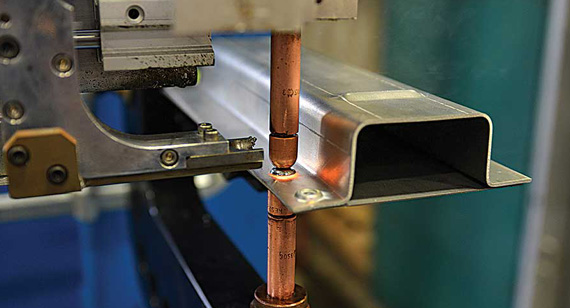
Advantages of Spot Welding
Speed and Efficiency
Spot welding is a rapid process, making it ideal for high-volume production lines. The ability to weld two parts together in a matter of seconds enhances the efficiency of mass production, especially when the components are made of sheet metal or other thin materials. For instance, spot welding is frequently used in automotive manufacturing to join body panels in seconds.
Cost-Effective
Since spot welding requires minimal consumables—such as filler materials or shielding gases—it is a cost-effective method for many industries. Additionally, its speed reduces labor costs and overall operational expenses, making it one of the most budget-friendly welding methods available.
No Need for Filler Materials
Unlike some other welding processes, spot welding does not require additional filler materials. The two workpieces are joined by applying heat and pressure, which causes a localized molten area that forms a strong bond once cooled. This eliminates the need for wires, rods, or other consumables, reducing overall material costs.
Strong, Durable Joints
Spot welding creates a robust joint due to the concentrated heat applied to the faying surfaces of the workpieces. The pressure applied during the welding process helps form a solid bond, offering mechanical strength comparable to other welding methods. Spot welding is particularly effective for joining thin metal sheets, which is why it's commonly used in industries such as automotive and electronics.
High Precision
Spot welding provides precise control over the welding area, which helps create consistent and uniform welds. The ability to control the size of the weld nugget allows for accurate, repeatable results in a high-volume setting. This precision makes spot welding ideal for use in applications where the quality of the weld is paramount.
Minimal Distortion
The localized heat and quick cooling inherent in the spot welding process mean that there is less heat distortion compared to other welding methods. As a result, spot welding is ideal for thin materials or components that could be damaged by excessive heat or distortion.
Disadvantages of Spot Welding
Limited to Thin Materials
One of the primary limitations of spot welding is that it is generally only effective for joining thin sheets of material, typically no more than 1/8-inch thick. It becomes increasingly difficult to apply sufficient heat and pressure to thicker materials, which can reduce the quality of the weld or cause incomplete bonding.
Surface Preparation is Crucial
For spot welding to be successful, the materials must have clean, oxide-free surfaces. Contaminants such as rust, grease, or paint can interfere with the process and result in weak welds or failure to bond. Therefore, proper surface preparation is essential for achieving high-quality spot welds.
Limited to Overlapping Joints
Spot welding works best when the materials are placed in an overlapping arrangement. This limitation makes it difficult to join parts that do not naturally fit into this configuration, such as non-overlapping edges or corners, unless specific adjustments are made in the welding technique.
Electrode Wear and Maintenance
The electrodes used in spot welding are subject to wear over time due to the high heat and pressure applied during the process. This wear can cause the quality of the welds to decline, leading to a need for regular maintenance or replacement of the electrodes, which adds to the cost and downtime of production.
Difficult to Weld Dissimilar Materials
Spot welding works well when joining materials of similar thickness and composition. However, welding dissimilar metals or materials with different thermal conductivities (such as aluminum and steel) can be problematic. It may require modifications to the equipment or even alternate welding methods to achieve a strong, durable weld.
Spot Welding Challenges
While spot welding is an efficient and effective method for many applications, there are several challenges that manufacturers must address to ensure high-quality results.
Material Thickness
As mentioned, spot welding is best suited for thin materials. When working with thicker metals, achieving a strong weld can be challenging. The process may require longer weld times, higher current, or special techniques to ensure the heat is evenly distributed.
Electrode Wear
Electrodes are subjected to significant heat and mechanical stress during the spot welding process. As they wear down, they may cause inconsistent welds or failure to create a strong joint. Regular monitoring and maintenance of the electrodes are necessary to maintain the quality of the welds.
Distortion Control
Another challenge is controlling distortion, especially with materials that have a low melting point or are prone to warping. Heat distortion can affect the final product’s shape, which may be detrimental to the overall functionality or appearance of the part. Managing the heat input, welding time, and electrode pressure is crucial to minimizing distortion.
Controlling distortion during spot welding is essential to maintaining the quality and shape of the welded components. Distortion occurs when uneven heating causes the material to expand and contract, leading to warping or twisting.
To reduce distortion, consider the following approaches:
Heat Input Control
The amount of heat generated during the welding process directly affects the degree of distortion. Lowering the welding current or reducing the welding time can help minimize distortion by controlling the heat input. This can be especially important when welding materials prone to warping, such as thin steel sheets.
Symmetrical Clamping
Using clamps or fixtures to hold the workpieces securely in place can help ensure even distribution of heat and pressure during the welding process. Proper clamping can prevent uneven distortion and maintain the overall shape of the parts being welded.
Multiple Welds
When welding large or complex components, it's often beneficial to use multiple spot welds rather than a single, large weld. This approach allows for more control over the heat distribution and reduces the likelihood of warping.
Gradual Cooling
Allowing the welded parts to cool gradually, rather than immediately quenching them with water or other cooling agents, can reduce the likelihood of thermal shock and distortion. Cooling the material slowly ensures that the heat is distributed more evenly, helping to prevent distortion.
Spot Weld Size and Placement
Carefully controlling the size and placement of the spot welds can also help manage distortion. By placing welds at specific points where heat buildup can be evenly distributed, manufacturers can minimize the overall effect of distortion.
Conclusion
Spot welding offers significant advantages, such as speed, cost-effectiveness, and minimal distortion, but it also comes with certain limitations and challenges. By understanding these advantages and disadvantages, as well as the challenges of the spot welding process, manufacturers can optimize their use of spot welding for various applications. When distortion is a concern, implementing proper heat control techniques and using the right materials can ensure high-quality, durable welds.
Achieving high-quality spot welds requires more than just the right equipment and materials. Successful spot welding relies heavily on the preparation of the metal pieces, controlling the welding environment, and managing the welding parameters. Here are some practical ways to ensure your spot welds are strong, reliable, and free from defects:
1. Testing Metal Pieces Before Welding
One of the first steps in ensuring high-quality spot welds is to thoroughly test the metal pieces before welding. This includes checking the thickness, surface condition, and overall integrity of the materials. It’s crucial to ensure that the metal is free from defects, such as cracks, corrosion, or weak spots, as these will significantly affect the quality of the weld.
2. Cleaning Metal Filler Wire
The quality of the filler wire used for spot welding plays a crucial role in achieving a strong bond. Contaminants on the filler wire can affect the welding process and lead to weak joints or weld failure.
3. Securing Things with Tape
In spot welding, it’s crucial to keep the components aligned and securely positioned during the welding process. Even slight movement of the pieces can lead to misalignment, which can result in weak or uneven welds.
4. Knowing the Area
Before beginning the welding process, it’s essential to know the exact area where you will be applying the spot weld. Understanding the material properties, the welding zone, and any potential obstacles is crucial for creating a strong and efficient joint.
5. Controlling Distortion with Splicing
Distortion can be a significant issue in spot welding, especially when working with thin metals or dissimilar materials. Uneven heat distribution can lead to warping or buckling of the materials.
6. Ensuring Filler Wire Strength
The strength of the filler wire plays a critical role in achieving strong and durable welds. Weak or improperly sized filler wire can result in insufficient bonding, making the joint prone to failure under stress.
7. Maintaining Heat Balance
Spot welding relies on the precise control of heat to create a strong bond. Too much heat can cause burn-through or excessive distortion, while too little heat can lead to weak welds that fail to hold the materials together.
8. Letting the Metal Cool
Finally, allowing the metal to cool properly after spot welding is a key step in ensuring a high-quality, durable weld.
Conclusion
By following these practical steps, you can significantly improve the quality of your spot welds. Proper preparation, attention to detail, and control over the welding process are key to producing strong, reliable joints. Whether you're working on a small-scale project or a large manufacturing run, ensuring high-quality spot welds can increase the longevity and functionality of the welded components.
While both tack welding and spot welding are commonly used techniques in the metalworking industry, they serve different purposes and are suitable for different applications. Understanding the distinctions between these two welding methods can help you choose the best option for your project.
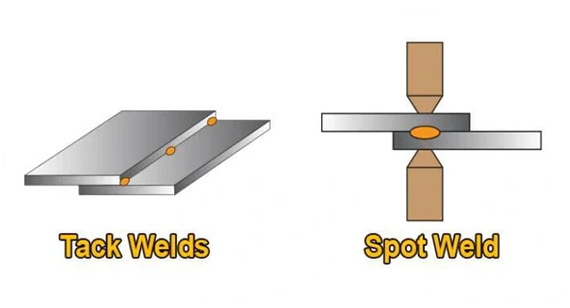
Tack Welding
Tack welding is a process used to temporarily hold metal parts together before performing the final welding operation. It involves applying small, short welds at various points along the joint to ensure proper alignment of the pieces. Tack welding is often used for positioning parts in preparation for more extensive welding, such as in cases where full penetration welds are needed.
Purpose: Primarily used to align components before the final weld.
Spot Welding
Spot welding, on the other hand, is a more permanent welding process that joins metal parts by applying pressure and heat at specific points. It is ideal for welding thin materials, especially in mass production settings, where precise control over the welding zone is required.
Key Differences
While spot welding is a widely used joining method, there are situations where it may not be the best option. In these cases, self-crushing fasteners provide a viable alternative. Self-crushing fasteners are mechanical components that are designed to fasten two pieces of material together by applying force. They are particularly useful when dealing with materials that are difficult to weld or where welding might compromise the integrity of the materials.
How Self-Crushing Fasteners Work
Self-crushing fasteners function by compressing the material around them as they are installed, creating a secure, tight fit. This compression can occur through methods such as mechanical expansion or threading, and the fastener "crushes" or deforms slightly, locking the materials in place.
Advantages:
Disadvantages:
Types of Self-Crushing Fasteners
Some common types of self-crushing fasteners include:
At VMT, we specialize in providing precision custom metal parts through advanced CNC machining services and other fabrication methods like spot welding, tack welding, and self-crushing fasteners. With years of experience in CNC machining and a state-of-the-art facility, we are equipped to handle the unique needs of your projects. Whether you're looking for custom CNC machining of metal parts, need CNC prototype machining, or require specific welding solutions, we ensure the highest quality standards and precision in every product.
Our Capabilities:
At VMT, we are committed to delivering high-quality, cost-effective solutions that help you meet your project deadlines. Our expert team works with you to ensure that every part is produced to the highest standards and that every weld and fastener performs optimally.
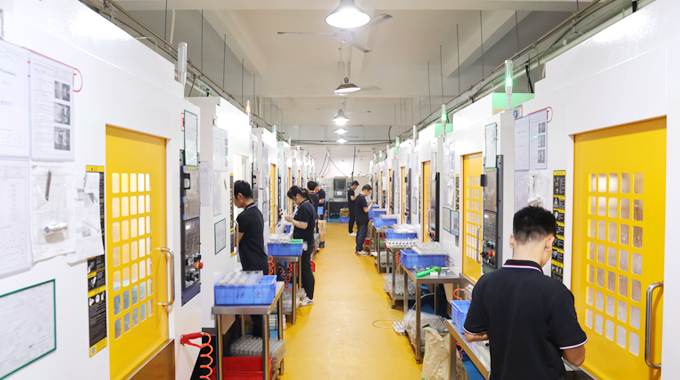
Understanding the differences between welding methods like tack welding and spot welding allows you to make an informed decision about which technique is best for your application. For materials that are difficult to weld, self-crushing fasteners provide a reliable alternative. Whether you need spot welding, self-crushing fasteners, or custom CNC machining services, VMT has the expertise and technology to deliver high-quality, durable solutions for your projects.
Why Do Spot Welds Crack?
Spot welds can crack for several reasons, including improper heat application, insufficient welding pressure, or poor material compatibility. If the heat or pressure isn't controlled correctly, the weld may not penetrate deeply enough or could lead to a brittle bond, which can crack under stress. Proper technique, material preparation, and welding parameters are crucial to avoiding this issue.
When Should You Spot Weld?
Spot welding is ideal when working with thin sheets of metal that need to be joined quickly and securely. It is especially useful in industries such as automotive manufacturing, where precision, speed, and strength are essential. Spot welding should be used when a permanent, localized joint is required, and mass production is needed.
What is the Spot Weld Symbol?
The spot weld symbol on technical drawings indicates the location and number of spot welds needed to join two materials. It typically appears as a small circle with a line through the center and may include additional markings, such as the number of welds or their placement on the material.
What Does Spot Weld Fix?
Spot welds are used to join two metal parts together at specific points. The process fixes the parts by applying heat and pressure, creating a bond at the contact points. Spot welds are commonly used for attaching thin metal sheets in various industries, such as automotive, electrical, and sheet metal fabrication.
What is a Bridge Spot Weld?
A bridge spot weld is a type of spot weld where a bridge or gap is intentionally left between the two materials being welded. This technique is useful in applications where the materials are too thin or need to be spaced apart for functional reasons, such as for expansion or contraction.
What is an Ideal Spot Weld?
An ideal spot weld is a clean, strong bond with proper penetration into the material, ensuring a reliable connection. The weld should have minimal spatter, a smooth, uniform appearance, and adequate strength to withstand the mechanical stresses placed on the joint. Factors like heat, pressure, and electrode size must be controlled to achieve a perfect weld.
Can You Spot Weld Aluminum?
Yes, spot welding can be used to join aluminum materials. However, aluminum has high thermal conductivity and a low melting point, making the process more challenging than welding other metals. Aluminum spot welding requires precise control over welding parameters like current and pressure to achieve a strong and durable weld.
Can You Spot Weld Stainless Steel?
Stainless steel is commonly spot welded, particularly in applications where corrosion resistance is important. The welding process requires careful control of heat and pressure, as stainless steel can be prone to distortion if not properly managed. With the right settings, spot welding can produce strong, high-quality joints in stainless steel.
Can You Spot Weld Cast Iron?
Spot welding cast iron is not recommended due to the material's brittle nature and poor thermal conductivity. Cast iron tends to crack under high heat and pressure, which can make it difficult to achieve a reliable weld. For cast iron, other welding methods, such as TIG or MIG welding, are generally preferred.
Can You Spot Weld Aluminum to Steel?
Spot welding aluminum to steel presents challenges due to the differences in their thermal conductivity and melting points. While it is possible to spot weld aluminum to steel, special techniques and equipment are required to create a strong, durable joint. In many cases, alternative joining methods, such as mechanical fasteners or adhesive bonding, may be preferred.
Can You Spot Weld Galvanized Steel?
Spot welding galvanized steel can be done, but the zinc coating can produce excessive fumes and cause porosity in the weld if not managed correctly. To weld galvanized steel successfully, the material should be cleaned properly to remove the coating from the weld area, and the right settings must be used to prevent damage to the base metal.
Is the Spot Weld Strong?
Yes, when done correctly, spot welds are strong and durable. They are designed to withstand mechanical stress and provide a permanent bond between materials. The strength of the spot weld depends on several factors, including the material being welded, the heat and pressure applied, and the quality of the welding process.
Can You Spot Weld Galvanized Steel?
Yes, spot welding is possible on galvanized steel, though it requires extra precautions. The zinc coating can produce fumes that interfere with the weld quality, so it’s essential to remove the coating from the weld area before starting the process. By adjusting the welding parameters and ensuring proper cleaning, galvanized steel can be successfully spot welded.
